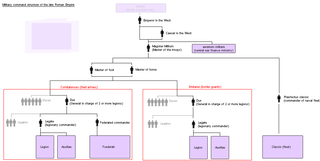 W
WThe allagion was a Byzantine military term designating a military unit of 50-400 soldiers. It first appeared in the mid-to-late 10th century, and by the 13th century had become the most frequent term used for the Byzantine army's standing regiments, persisting until the late 14th century.
 W
WThe Opsician Theme or simply Opsikion was a Byzantine theme located in northwestern Asia Minor. Created from the imperial retinue army, the Opsikion was the largest and most prestigious of the early themes, being located closest to Constantinople. Involved in several revolts in the 8th century, it was split in three after ca. 750, and lost its former pre-eminence. It survived as a middle-tier theme until after the Fourth Crusade.
 W
WThe Count of the Tent was a Byzantine military-administrative office attested from the 8th to the early 12th centuries.
 W
WThe office of the Domestic of the Schools was a senior military post of the Byzantine Empire, extant from the 8th century until at least the early 14th century. Originally simply the commander of the Scholai, the senior of the elite tagmata regiments, the Domestic quickly rose in prominence: by the mid-9th century, its holders essentially occupied the position of commander-in-chief of the Byzantine army, next to the Emperor. The office was eclipsed in the 12th century by that of the Grand Domestic, and in the Palaiologan period, it was reduced to a purely honorary, mid-level court dignity.
 W
WThe droungarios of the Fleet, sometimes anglicized as Drungary of the Fleet, was the commander of the Imperial Fleet, the central division of the Byzantine navy stationed at the capital of Constantinople, as opposed to the provincial (thematic) fleets. From the late 11th century, when the Byzantine fleets were amalgamated into a single force under the megas doux, the post, now known as the Grand droungarios of the Fleet, became the second-in-command of the megas doux and continued in this role until the end of the Byzantine Empire.
 W
WThe katepánō was a senior Byzantine military rank and office. The word was Latinized as capetanus/catepan, and its meaning seems to have merged with that of the Italian "capitaneus". This hybridized term gave rise to the English language term captain and its equivalents in other languages
 W
WMagister militum was a top-level military command used in the later Roman Empire, dating from the reign of Constantine the Great. The term referred to the senior military officer of the Empire. In Greek sources, the term is translated either as strategos or as stratelates.
 W
WMagister militum was a top-level military command used in the later Roman Empire, dating from the reign of Constantine the Great. The term referred to the senior military officer of the Empire. In Greek sources, the term is translated either as strategos or as stratelates.
 W
WMagister militum was a top-level military command used in the later Roman Empire, dating from the reign of Constantine the Great. The term referred to the senior military officer of the Empire. In Greek sources, the term is translated either as strategos or as stratelates.
 W
WMagister militum was a top-level military command used in the later Roman Empire, dating from the reign of Constantine the Great. The term referred to the senior military officer of the Empire. In Greek sources, the term is translated either as strategos or as stratelates.
 W
WMagister militum was a top-level military command used in the later Roman Empire, dating from the reign of Constantine the Great. The term referred to the senior military officer of the Empire. In Greek sources, the term is translated either as strategos or as stratelates.
 W
WThe megas doux was one of the highest positions in the hierarchy of the later Byzantine Empire, denoting the commander-in-chief of the Byzantine navy. It is sometimes also given in English by the half-Latinizations megaduke or megadux. The Greek word δούξ is the Hellenized form of the Latin term dux, meaning leader or commander.
 W
WStrategos, plural strategoi, Latinized strategus, is used in Greek to mean military general. In the Hellenistic world and the Byzantine Empire the term was also used to describe a military governor. In the modern Hellenic Army it is the highest officer rank.
 W
WStrategos, plural strategoi, Latinized strategus, is used in Greek to mean military general. In the Hellenistic world and the Byzantine Empire the term was also used to describe a military governor. In the modern Hellenic Army it is the highest officer rank.
 W
WAutokratōr is a Greek epithet applied to an individual who is unrestrained by superiors. It has been applied to military commanders-in-chief as well as Roman and Byzantine emperors as the translation of the Latin title imperator. Its connection with Byzantine-style absolutism gave rise to the modern terms autocrat and autocracy. In Modern Greek, it means "emperor", and its feminine form is autokráteira.
 W
WStratēlatēs was a Greek term designating a general, which also became an honorary dignity in the Byzantine Empire. In the former sense, it was often applied to military saints, such as Theodore Stratelates.
 W
WStratopedarchēs, sometimes Anglicized as Stratopedarch, was a Greek term used with regard to high-ranking military commanders from the 1st century BC on, becoming a proper office in the 10th-century Byzantine Empire. It continued to be employed as a designation, and a proper title, of commanders-in-chief until the 13th century, when the title of megas stratopedarchēs or Grand Stratopedarch appeared. This title was awarded to senior commanders and officials, while the ordinary stratopedarchai were henceforth low-ranking military officials.